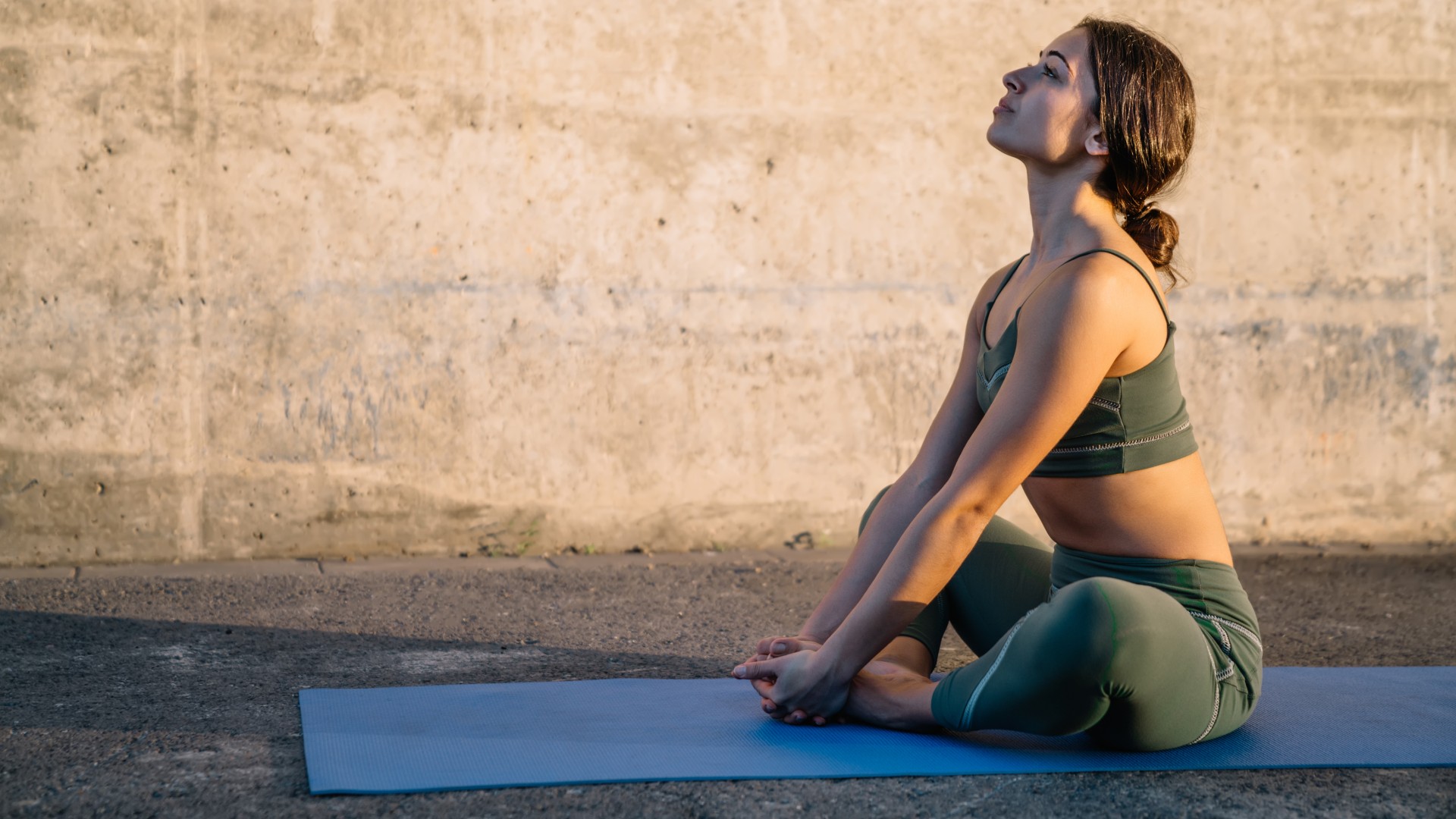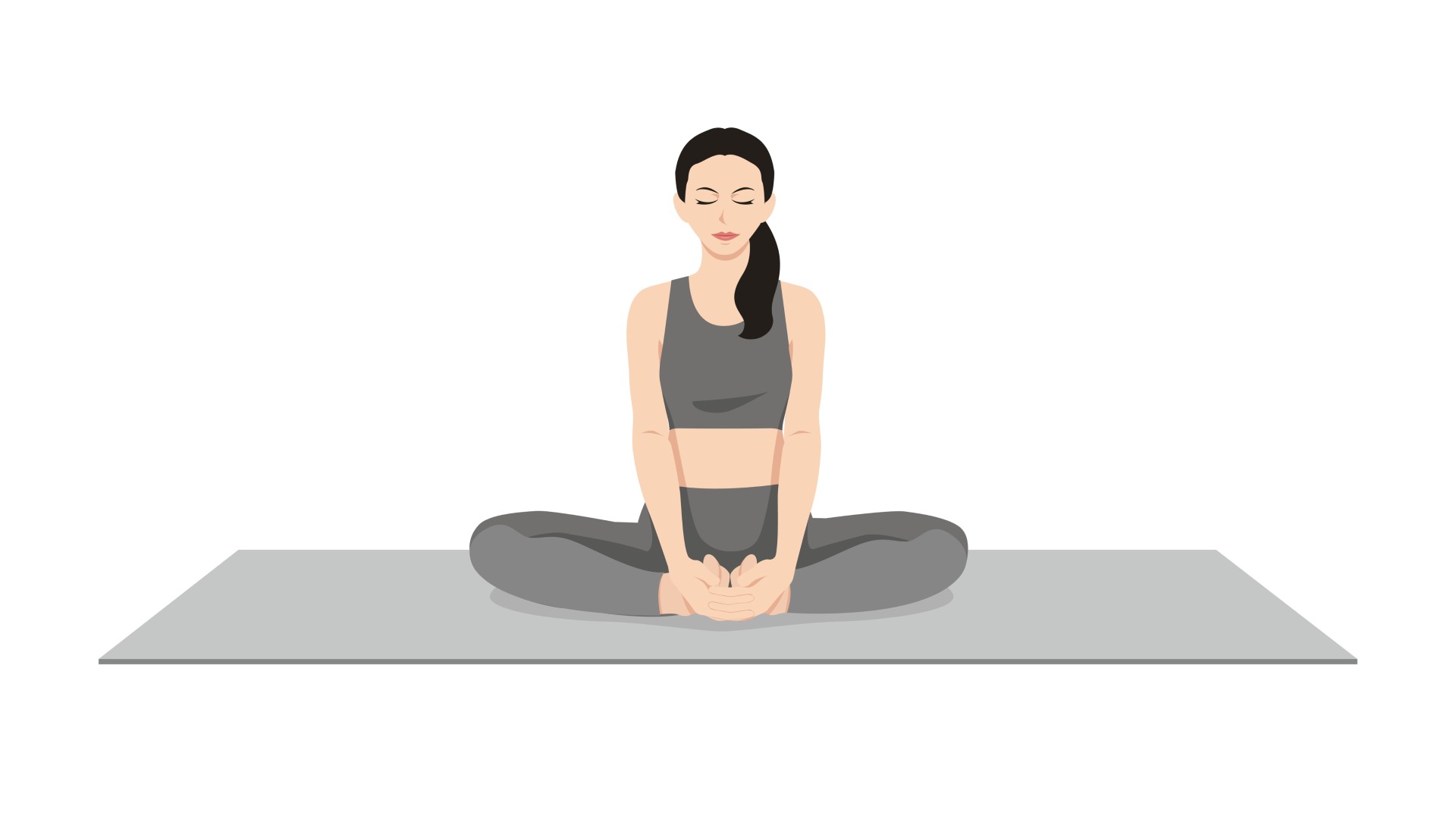
The butterfly pose is the stretching exercise you should add to your routine if you have tight hips and inner thighs, and it can even release tension in your lower back. If your interest is piqued, find out what happened when I practiced the butterfly pose every day for one week.
Butterfly, also known as Bound Angel pose or Baddha Konasana in Sanskrit (for the yogis), is a hip opener used in yoga and wider fitness circles as a static stretching exercise for the lower body. To do it, simply draw the soles of your feet together and open your knees toward the floor, allowing them to soften on either side of you.
I added the move to my daily routine, spending three minutes in butterfly before bedtime each day, and it had a lasting impact on my hips and groin. Here’s what happened after seven days and why I’ve since added the exercise to my life. Roll out one of the best yoga mats for home practice, and read on.
How to do butterfly pose

Butterfly pose is suitable for beginners and all levels of fitness, helping to relieve tight muscles and tension in the lower body. However, if you’re pregnant, have just given birth, or have recently suffered an injury, speak with your physician before undertaking any new exercises, and seek the advice of a yoga instructor if you’re still unsure. Those who suffer from symptoms of sciatica might also want to skip this exercise.
How:
- Start seated on your bum and position the soles of your feet together in front of you. Have your feet further away from you, creating a diamond shape, then draw your heels closer toward your pelvis as you develop flexibility.
- Take a deep breath in, then, as you exhale, fold forward at your hips and lower your chest toward your legs. The spine can softly round but not excessively.
- Allow your knees to fall toward the floor, and relax both legs.
- Place your hands on the floor in front of you. Walk your hands away from you to add a deeper upper-body stretch.
- Hold. Don’t force the stretch and relax the body with every exhale.
- To exit the posture, walk your hands back in and slowly sit up, straightening your back as you lift your chest.
If folding forward feels too intense, start by sitting and focus on softening your legs to the floor.
I did the 3-minute butterfly pose exercise every day for one week — here are my results
It’s important to understand that no drastic changes happen to your body in one week. Depending on the exercise you undertake, we’re not talking about huge strength gains, sculpting muscle, or shredding fat, for example. But daily stretching can quite quickly have a positive impact on the muscles, although you’d need to keep up a routine if you plan to see progression over time. Here’s what I experienced.
Sign up to get the BEST of Tom's Guide direct to your inbox.
Get instant access to breaking news, the hottest reviews, great deals and helpful tips.
I love the pose
I’ve developed quite good flexibility around my hips, groin, inner thighs (the adductors) and hamstrings already, so the butterfly isn’t as tough for me as it could be for others. That said, I’m the most impatient person in the world (my partner can’t queue up anywhere with me as a direct result of this), and the challenge for me has been practicing the art of patience.
Three minutes doesn’t seem like a long time, but I get bored quickly; this has been a great test of breath focus, allowing me to fall deeper into a butterfly pose and focus on how my body feels without rushing to move on. Turns out, when I can stay still, I love this stretch even more, and I feel relaxed afterward.
I've already noticed positive changes in my lower body
Having been to the personal hell of a 3-minute frog pose every day for a week, I thought I’d cruise through this stretching challenge, but I was wrong. Initially, my mid-back felt tight, and I couldn’t settle to my breathing — the trick is to breathe toward your belly and use an expansive inhale as if directing your breath around the body.
By the end of the week, my lower back, hips and groin felt more open, and I could semi-comfortably sit with my chest resting on my legs for the full three minutes. It’s worth mentioning that this is far from the point of the hip opener — you should always seek a sustainable position you can hold without experiencing pain. It’s a hip opener for a reason though, so it should feel challenging enough to develop flexibility in the area, and you can adjust the intensity by moving your heels closer to your hips (harder) or further away (easier).
You must keep going
Do you know how loose you feel after stretching? Funny how a few hours later, you feel tight again. While stretching, the Golgi Tendon Organ (GTO) can sense tension in the muscles and send information to the brain. The GTO can also interrupt your muscle spindle activity to help you reach a deeper stretch — it’s your body’s way of saying ‘chill out’ to your muscles. Hence, I could move more deeply into a butterfly as the minutes ticked by.
However, your stretch reflex prevents overstretching, so once you stop stretching and return to normal, muscles may feel tight again after some hours.
Over the years, there has been some debate on the efficacy of stretching in reducing the likelihood of injury or muscle soreness after workouts. And the studies are mixed. That said, most fitness professionals (myself included) save static stretches after a workout to help improve flexibility and range of motion without hindering performance. Coupled with dynamic movements found in yoga or preparatory exercises before a workout, it could improve overall mobility.
Having been to the personal hell of a 3-minute frog pose every day for a week, I thought I’d cruise through this stretching challenge, but I was wrong.
The Mayo Clinic also says that stretching could improve flexibility and increase muscle blood flow, helping you with daily activities and performance during physical activity. But the trick is to keep going. Like anything in life, you’ll need to practice regularly to see any results, and for butterfly pose, at least 3-5 minutes each time (or more if you can) is ideal.
It helped me stretch my back
Many yoga teachers say the butterfly pose stretches your back and could help improve posture and strengthen your core (you’ll need to use your core muscles to prevent collapsing into your back or rounding your spine). On days when my muscles felt super tight after a CrossFit class, I found the stretch more intense in my back. I practiced wrapping my hands around my feet, drawing my elbows in, keeping my heels close to my body and using my exhale to soften.
I did the 3-minute butterfly pose every day for a week — here’s my verdict
I’ve loved trying this pose every day, and I’ve found an even more delicious variation of butterfly pose to help you drift off to sleep — a reclined butterfly. To do it, start in butterfly pose, then lay back onto a mattress, pillow, or bolster with your arms by your sides or overhead behind you and focus on breathing. I added this to my routine on several evenings, which helped me relax before switching off for the night.
If you spend long hours at your desk like me, a butterfly helps counteract the effects of sitting or intense workouts. If you prefer to lean forward with tight hips, fold a pillow or bolster beneath your elbows or support your knees on yoga blocks instead.
Butterfly pose has delivered for the health of my hips and helped me shake off sitting at my desk for longer than I’m supposed to, but what works for me might not work for you, so always speak with a yoga teacher when deciding whether to adjust or develop a pose.
More from Tom's Guide

Sam Hopes is a level 3 qualified trainer, level 2 reiki practitioner and senior fitness writer at Tom's Guide. She is also currently undertaking her Yoga For Athletes training course. Sam has written for various fitness brands and websites over the years and has experience across brands at Future such as Live Science, Fit&Well, Coach, and T3.
Having worked with fitness studios like F45 and Virgin Active, Sam now primarily teaches outdoor bootcamps, bodyweight, calisthenics and kettlebells. She also coaches mobility and stretching-focused classes several times a week and believes that true strength comes from a holistic approach to training your body.
Sam has completed two mixed doubles Hyrox competitions in London and the Netherlands and finished her first doubles attempt in 1:11.
